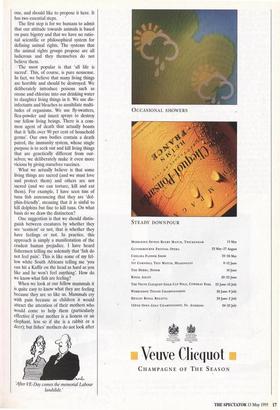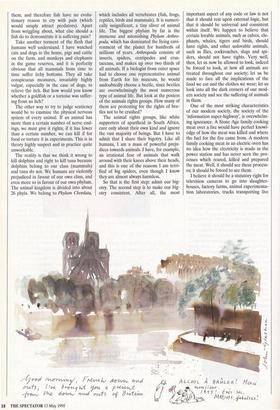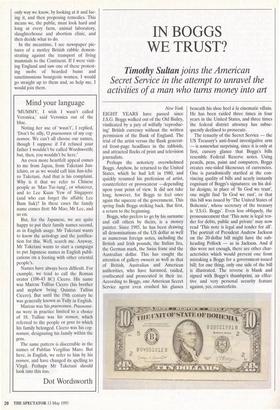WHY MURDER IS WRONG
Andrew Kenny argues that we should
all be forced to witness the slaughter of animals and the abortion of tiny babies
Cape Town I HAVE personally witnessed the last ter- rible moments of the same creatures that are being transported alive to their deaths around the ports of Britain. Let me describe them to you, and let me assume that these animals suffer the same terror and pain as humans would — what else can we assume? — and ask you to imagine these deaths happening to you. Persons of a squeamish disposition should stop read- ing now.
You are in your natural habitat, your drawing-room or a restaurant, with your family and friends, when suddenly you are crushed against your companions by strong ropes, hauled out of the room and thrown into a chamber of poisonous gas. The pressure in the chamber is so low that your stomach bursts out of your mouth and your intestines burst out of your anus. Alternatively, a great meat-hook comes into your living-room, thrusts into your mouth and stabs upwards through the roof of your mouth to emerge through your cheek or your eye, and then drags you into the gas chamber. In the chamber, your whole body thrashes about in excruciating pain. If you are lucky, a giant alien with a huge knife will slit your body open from your throat to your groin, rip out your lungs, heart and guts, and then chop off your head. Otherwise you will die a slow, agonising death by asphyxiation.
I am, of course, referring to the fish caught by lines and nets around the coast of Britain which are not humanely killed, but lie alive and writhing on the decks of the fishing boats until eventually they suf- focate or are gutted. On a South African trawler, I saw fish dragged up from the high pressure of deep water into the low pressure of our air, so that their internal organs bulged out of their body orifices in horrible pink balloons. Such horror. Such suffering.
But strangely enough, although I read of animal rights groups protesting about the transport of live calves from Britain to abattoirs in Europe, I do not read of any of them protesting about our greater cruelty towards fish. Such wild inconsistency gives reason for the veal farmers to jeer at them.
I have been a vegetarian for the last 27 years, not for reasons of health or religion but as a protest against human cruelty to animals. I do not eat the meat of mammals or birds, but I do eat fish and dairy prod- ucts, and I am only too aware of my own lack of logic. Over these years I have been brooding about the problem and searching for some workable and consistent system of animal rights. I believe I have thought of one, and should like to propose it here. It has two essential steps. '
The first step is for we humans to admit that our attitude towards animals is based on pure bigotry and that we have no ratio- nal scientific or philosophical system for defining animal rights. The systems that the animal rights groups propose are all ludicrous and they themselves do not believe them.
The most popular is that 'all life is sacred'. This, of course, is pure nonsense. In fact, we believe that many living things are horrible and should be destroyed. We deliberately introduce poisons such as ozone and chlorine into our drinking water to slaughter living things in it. We use dis- infectants and bleaches to annihilate multi- tudes of organisms. We use fly-swatters, flea-powder and insect sprays to destroy our fellow living beings. There is a com- mon agent of death that actually boasts that it 'kills over 90 per cent of household germs'. Our own bodies contain a death patrol, the immunity system, whose single purpose is to seek out and kill living things that are genetically different from out- selves; we deliberately make it even more vicious by giving ourselves vaccines.
What we actually believe is that some living things are sacred (and we must love and protect them) and others are not sacred (and we can torture, kill and eat them). For example, I have seen tins of tuna fish announcing that they are 'dol- phin-friendly', meaning that it is sinful to kill dolphins but fine to kill tuna. On what basis do we draw the distinction?
One suggestion is that we should distin- guish between creatures by whether they are 'sentient' or not, that is whether they have feelings or not. In practice, this approach is simply a manifestation of the crudest human prejudice. I have heard fishermen telling me solemnly that 'fish do not feel pain'. This is like some of my fel- low white South Africans telling me 'you can hit a Kaffir on the head as hard as you like and he won't feel anything'. How do we know what fish are feeling?
When we look at our fellow mammals it is quite easy to know what they are feeling because they are so like us. Mammals cry with pain because as children it would attract the attention of their mothers who would come to help them (particularly effective if your mother is a lioness or an elephant, less so if she is a rabbit or a deer); but fishes' mothers do not look after After VE-Day comes the memorial Labour landslide.' them, and therefore fish have no evolu- tionary reason to cry with pain (which would simply attract predators). Apart from wriggling about, what else should a fish do to demonstrate it is suffering pain? Take another torment of the flesh that humans well understand. I have watched cats and dogs in the home, pigs and cattle on the farm, and monkeys and elephants in the game reserves, and it is perfectly obvious that all mammals from time to time suffer itchy bottoms. They all take conspicuous measures, invariably highly vulgar, especially in the case of dogs, to relieve the itch. But how would you know whether a goldfish or a tortoise was suffer- ing from an itch? The other way to try to judge sentiency would be to examine the physical nervous system of every animal. If an animal has more than a certain number of nerve end- ings, we must give it rights; if it has fewer than a certain number, we can kill if for food or torture it in experiments. This is in theory highly suspect and in practice quite unworkable. The reality is that we think it wrong to kill dolphins and right to kill tuna because dolphins belong to our class (mammals) and tuna do not. We humans are violently prejudiced in favour of our own class, and even more so in favour of our own phylum. The animal kingdom is divided into about 26 phyla. We belong to Phylum Chordata, which includes all vertebrates (fish, frogs, reptiles, birds and mammals). It is numeri- cally insignificant, a tiny sliver of animal life. The biggest phylum by far is the immense and astonishing Phylum Arthro- poda, which has dominated the living envi- ronment of the planet for hundreds of millions of years. Arthropoda consists of insects, spiders, centipedes and crus- taceans, and makes up over two thirds of all animals. If a biologist from outer space had to choose one representative animal from Earth for his museum, he would undoubtedly choose a beetle, since beetles are overwhelmingly the most numerous type of animal life. But look at the posters of the animals rights groups. How many of them are protesting for the rights of bee- tles not to be crushed? The animal rights groups, like white supporters of apartheid in South Africa, care only about their own kind and ignore the vast majority of beings. But I have to admit that I share their bigotry. Like all humans, I am a mass of powerful preju- dices towards animals. I have, for example, an irrational fear of animals that walk around with their knees above their heads, and this is one of the reasons I am terri- fied of big spiders, even though I know they are almost always harmless. So that is the first step: admit our big- otry. The second step is to make our big- otry consistent. After all, the most important aspect of any code or law is not that it should rest upon external logic, but that it should be universal and consistent within itself. We happen to believe that certain lovable animals, such as calves, ele- phants, whales, tigers and birds, should have rights, and other unlovable animals, such as flies, cockroaches, slugs and spi- ders, should not have rights. Very well, then, let us now be allowed to look, indeed be forced to look, at how all animals are treated throughout our society; let us be made to face all the implications of the food we eat and the clothes we wear; let us look into all the dark corners of our mod- ern society and see the suffering of animals in them. One of the most striking characteristics of our modern society, the society of the `information super-highway', is overwhelm- ing ignorance. A Stone Age family cooking meat over a fire would have perfect knowl- edge of how the meat was killed and where the fuel for the fire came from. A modern family cooking meat in an electric oven has no idea how the electricity is made in the power station and has never seen the pro- cesses which reared, killed and prepared the meat. Well, it should see these process- es; it should be forced to see them. I believe it should be a statutory right for television cameras to go into slaughter- houses, factory farms, animal experimenta- tion laboratories, trucks transporting live animals, fishing boats and every other place where animals are kept and killed, and the resulting films should be shown on national television. At the moment there is an unspoken conspiracy between those who eat animals and those who farm ani- mals about how the animals live and die: the meat-eaters do not want to see and the meat-farmers do not want to show. The conspiracy must end. Both must be forced to face up to what they are doing with the animals.
People who drink milk and eat cheese should be made to see the slaughter of the calves whose birth is necessary for the cows to produce milk. People who buy cos- metics tested on animals should be forced to see rabbits' eyes being deliberately burnt out. People who eat pork sausages should see pigs crowded together in ghast- ly pens and piglets being castrated. People who eat chickens and eggs should see the horrors of a battery farm. And all meat- eaters should see the terror, blood, viscera and severed heads of a slaughterhouse.
Then, when we have all seen and all faced up to the monstrous suffering of ani-. mals that end up on our plates, we can decide what killing is allowed and what is not allowed, and which animals should have rights and which should not. Our decisions would, of course, be emotional, but consistently so. Instead of the present state, where we have sudden bursts of sen- timent over selected animal suffering, such as over the transport of calves or the hunt- ing of foxes, we would have a complete picture of all animal suffering and could make informed decisions on animal wel- fare.
Animals are not moral beings — they cannot distinguish between right and wrong — and so they cannot have respon- sibilities. None the less I believe they should have rights. There is a category of human beings which similarly have rights without responsibilities: newly born babies and unborn babies, which present some- what similar ethical problems.
I am an atheist and therefore I agree completely with the Pope on abortion. The logic is simple. As a human I must have a moral code. I believe murder is wrong. Murder is the taking of human life. The atheist definition of life is a certain level of chemical organisation and of human life a certain higher level. That chemical organi- sation is exactly defined by the DNA molecule. For every individual the DNA is completely formed at the moment of con- ception. Therefore all abortion is murder.
But this logic of popes and atheists crumbles before a 12-year-old girl who is ten minutes pregnant after having been raped by her syphilitic father. Then, undoubtedly, I should approve of an abor- tion. As with my eating fish but not beef, I am aware of my illogic, and I see this illog- ic on a huge scale in the furious public debate on abortion. I propose exactly the same solution as with the animals. Let us see, let us be forced to see, what abortion really is.
Again television crews should have the statutory right to go into any abortion clin- ics and film the foetuses (although not the mothers). Let us have bright daylight in this dark corner. The pro-choice side, which believes in a mother's right to kill her baby, does not want such illumination. A cousin of mine was representing the Society for the Protection of the Unborn Child (SPUC) in a debate in England against the pro-abortionists, who kept speaking about 'the uterine contents' and `the foetal jelly'. Then one of the SPUC people said she would show everybody what they were really talking about, and she held up a large jar containing a five- month-old foetus. There was horror and outrage from the abortionists. They did not want the public to see the truth. But the public must see the truth if it is to under- stand the full'S meaning of abortion and • make properly informed decisions. It must see the little dead bodies.
We humans in the western world are aware that we are doing evil to beings over whom we have dominion. Because we are human, and therefore bigoted and irra- tional, we cannot scientifically define the evil. So we must approach the evil in the only way we know, by looking at it and fac- ing it, and then proposing remedies. This means we, the public, must look hard and long at every farm, animal laboratory, slaughterhouse and abortion clinic, and then decide what to do.
In the meantime, I see newspaper pic- tures of a motley British rabble demon- strating against the transport of living mammals to the Continent. If I were visit- ing England and saw one of these protest- ing mobs of bearded bums and sanctimonious bourgeois women, I would go straight up to them and, so help me, I would join them.






































































 Previous page
Previous page